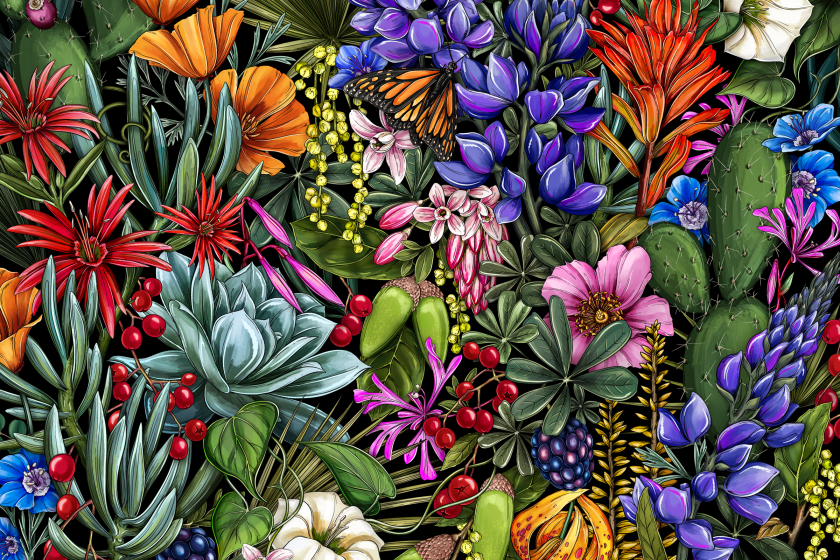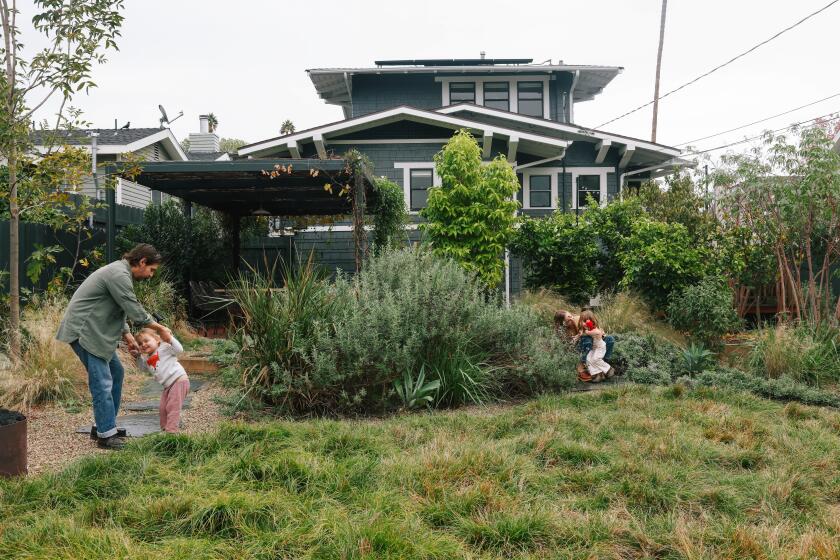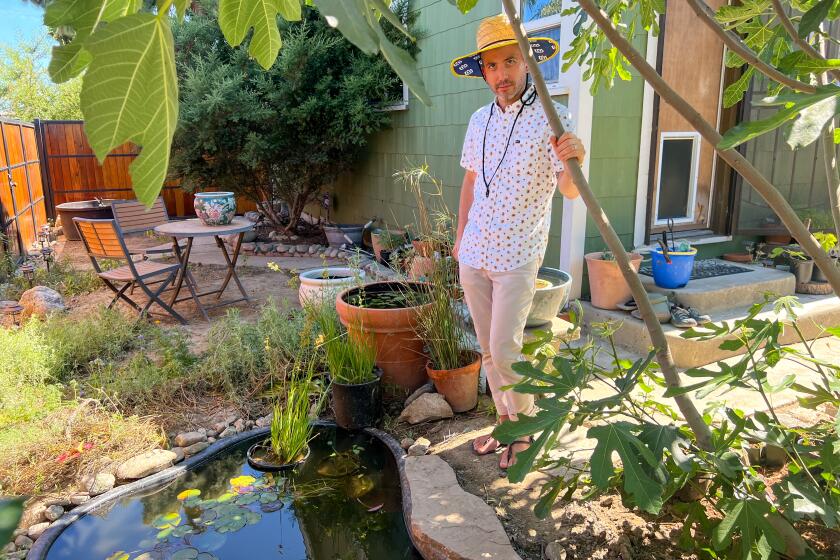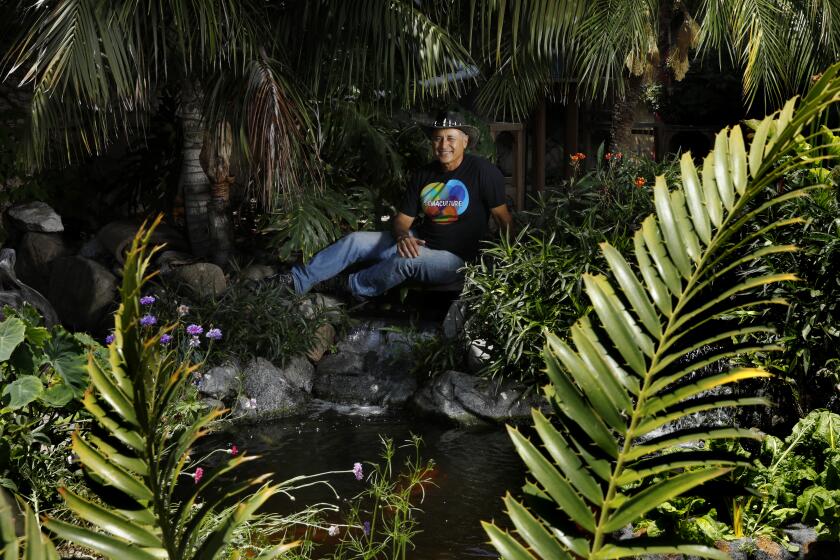
- Share via
If a wildlife show wanted to film in the middle of Los Angeles, Casa Apocalyptica — a dizzying jungle of native plants, abundant wildlife, soothing water and salvaged debris — would be a great place to land.
Here, slender salamanders slink through the leaf litter under robust stands of Santa Cruz Island buckwheat and California fuchsia. Dozens of bright red flame skimmer dragonflies chase around a hand-dug pond and rubble-strewn stream.
By day, birdsong is as omnipresent as Muzak at a mall; frogs serenade the night. Near the house, a couple of koi as big as human babies lurch out of their long, raised pool for a head pat and their favorite treat — slices of watermelon.
Except for a few fruit trees, almost every plant in the ground is native to California, including the Roger’s Red grapes that grow in a lush tangle over arbored patios, cooling the temperatures beneath a good 10 degrees — and all thriving without regular irrigation.
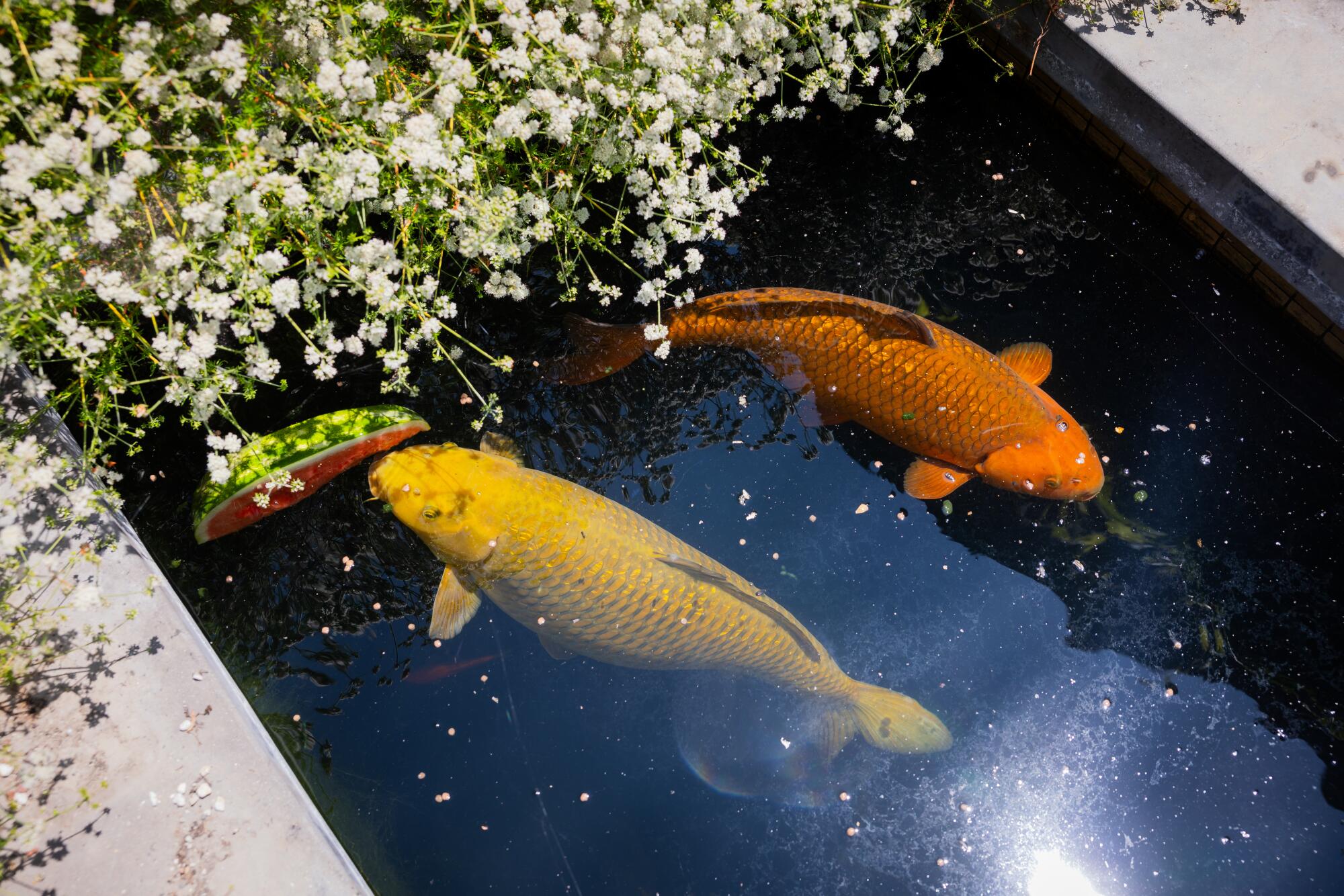
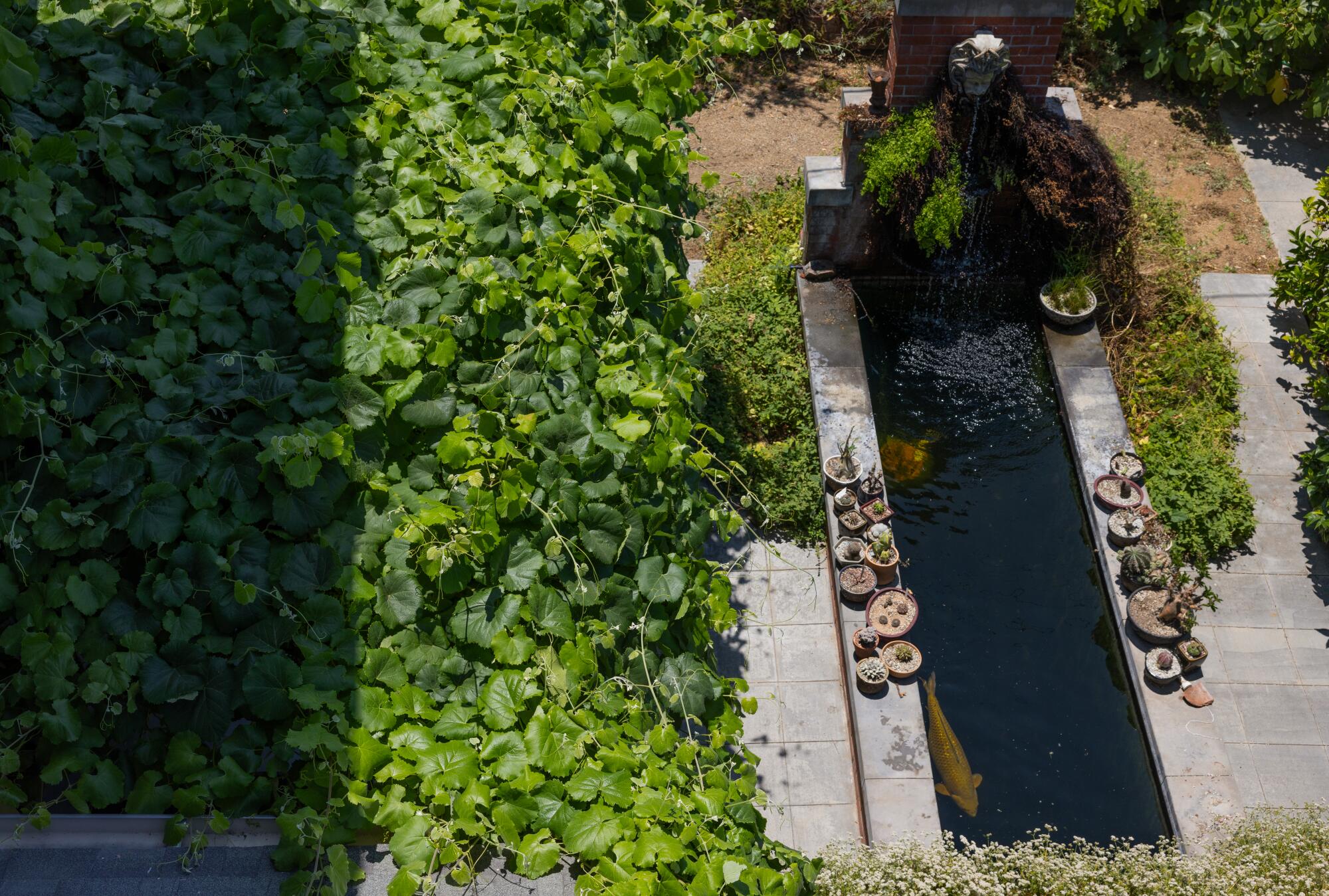
And most remarkable: This whole part art, part wilderness adventure is contained in the sloping, 12,000-square-foot yard that surrounds a grand 1910 Craftsman home renovated by Chris Elwell and Kory Odell after the spouses bought the dilapidated property in 2003 in the small Mid-Wilshire neighborhood known as Oxford Square.
Their abundant native landscape growing out of 100 years of detritus-turned-garden treasures has earned them mythic status in the native plant world, and made them a must-see fixture on the Theodore Payne Foundation’s spring Native Plant Garden Tours for more than a decade.
Here are the best retail native plant nurseries in Southern California to help you create a habitat for birds and pollinators in your yard or even on a patio.
“Casa Apocalyptica imagines our native ecology returning through the rubble after people are gone,’” the couple wrote in this year’s garden tour explainer. But nature got a lot of help from the two men, and if they’d known then how much work it would require, Elwell said, shaking his head, who knows if they would have gone ahead.
Except, listening to them talk, it’s clearly work they relished.
They’d wanted to move into a neighborhood of old homes in 2003, but the massive Craftsman mansion they chose was in terrible shape. Bars covered every window, neither the plumbing nor the electricity worked and all the trademark natural wood had been painted white. The backyard was full of rubble.
“Our friends and family thought we were nuts. They were like, ‘Why are you putting all this time and effort into this old wreck of a house?’” Elwell said.
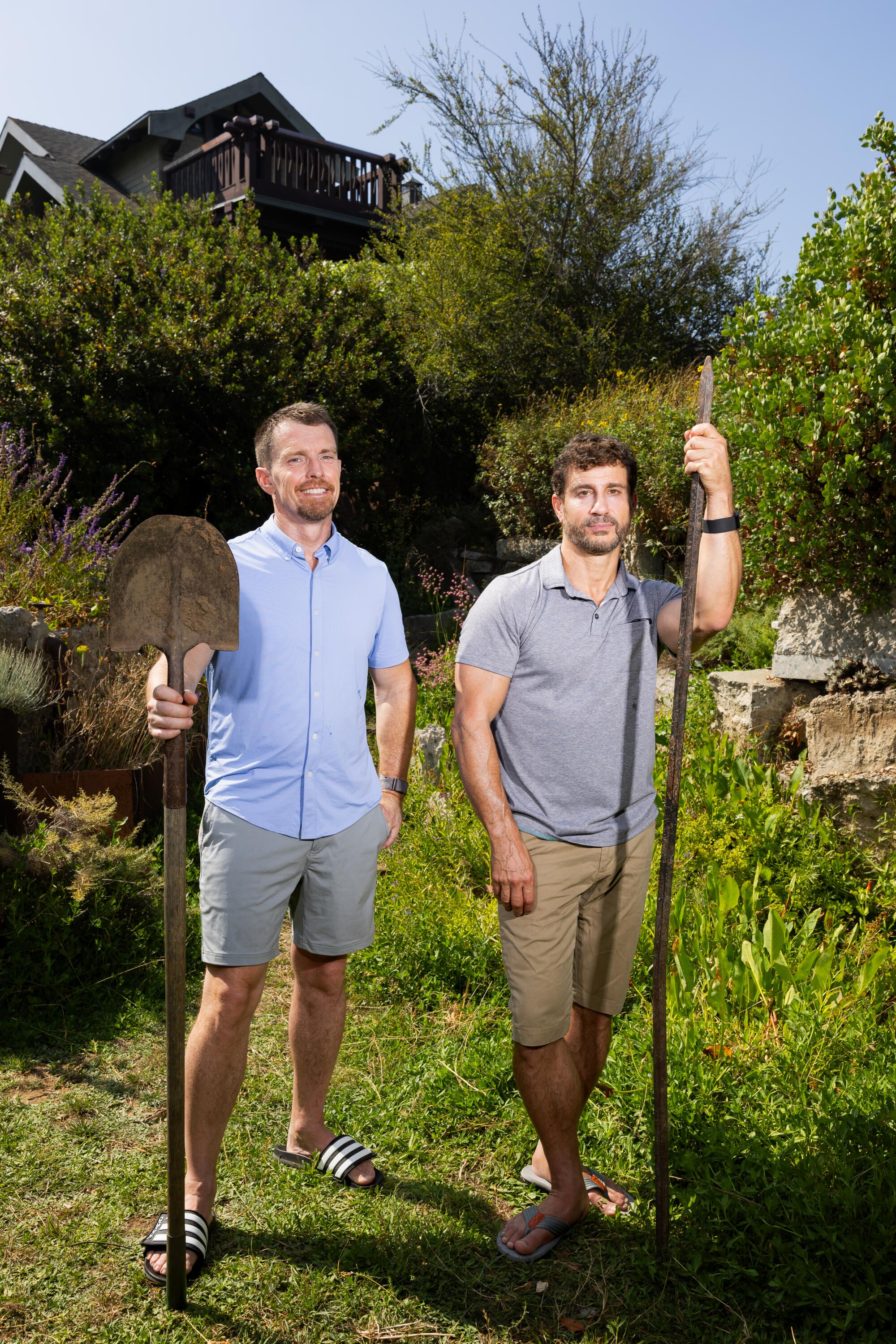
“But Kory had grown up working on houses, and we wanted a project, and a big yard for a garden,” he added. “The house was more than we’d bargained for, but we were obsessed with building something ourselves and making it authentic to us. And I like the beauty of things that are being overlooked. I felt like there were all these cool neighborhoods right under our noses and everybody’s ignoring them.”
The restoration took most of their free time, but it was also therapeutic, an artistic outlet after a stressful day at work, Elwell said. “But the garden sat for some time because we had so much to do on the house.”
It wasn’t until 2007 that they began on the yard, Elwell said, and both were still working full-time. Odell, now part of the executive team building the Metro Purple Line, was working with a midsize construction firm. And Elwell, now retired, was a television distribution executive with Sony Pictures.
Kyle and Claire Penn pulled out their lawn in Eagle Rock and never looked back. “We haven’t given up anything by not being able to run around on grass,” Kyle says.
Once again, their free time went to transformation. The front yard was a dense thicket of “freeway ice plant” that required several dumpster loads to haul away, and the bare-dirt sloping backyard was full of interesting trash that people had been dumping for 100 years — “old motorcycle parts, water heaters from the 1920s, horseshoes, lots of whiskey bottles, and lots of old cobblestones and bricks and building materials.”
To their eyes, the “junk” was weirdly wonderful, and it gave them their theme: L.A. after the apocalypse, with native plants growing in and around society’s broken remains.
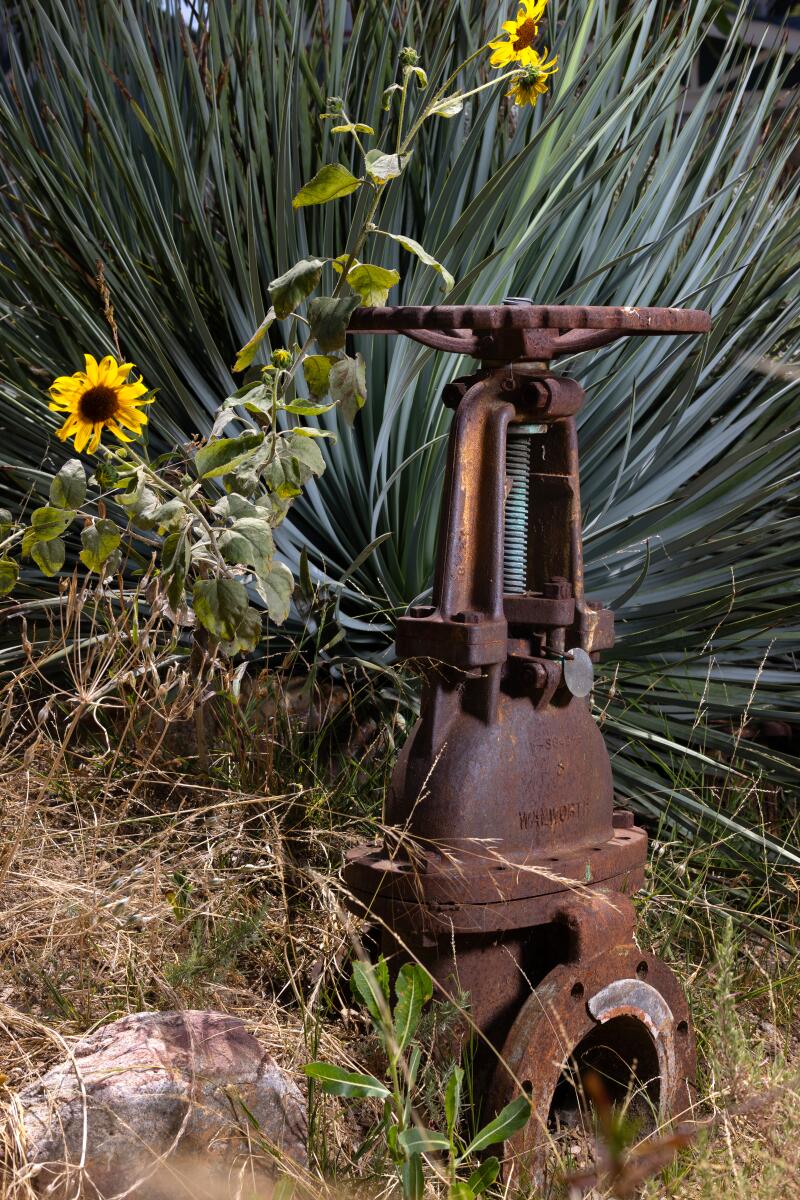
A rusted metal contraption sits surrounded by plants.
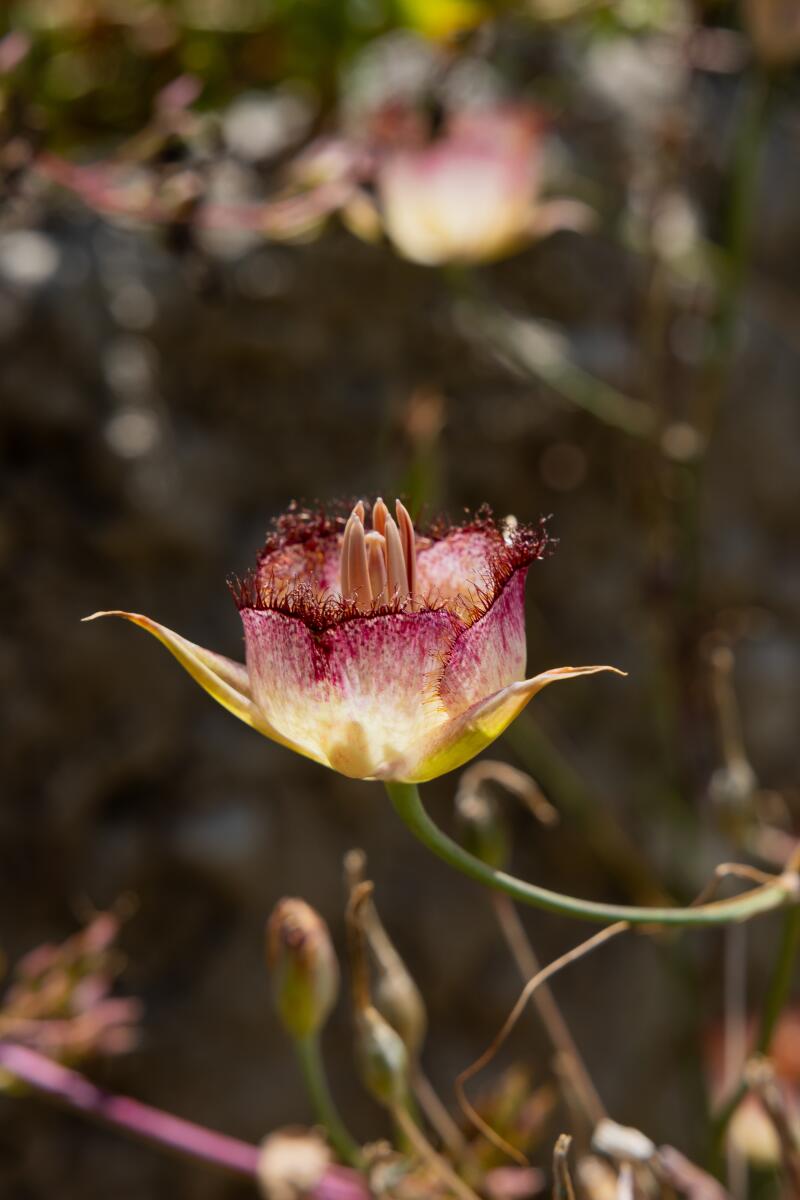
Plummer’s mariposa lily.
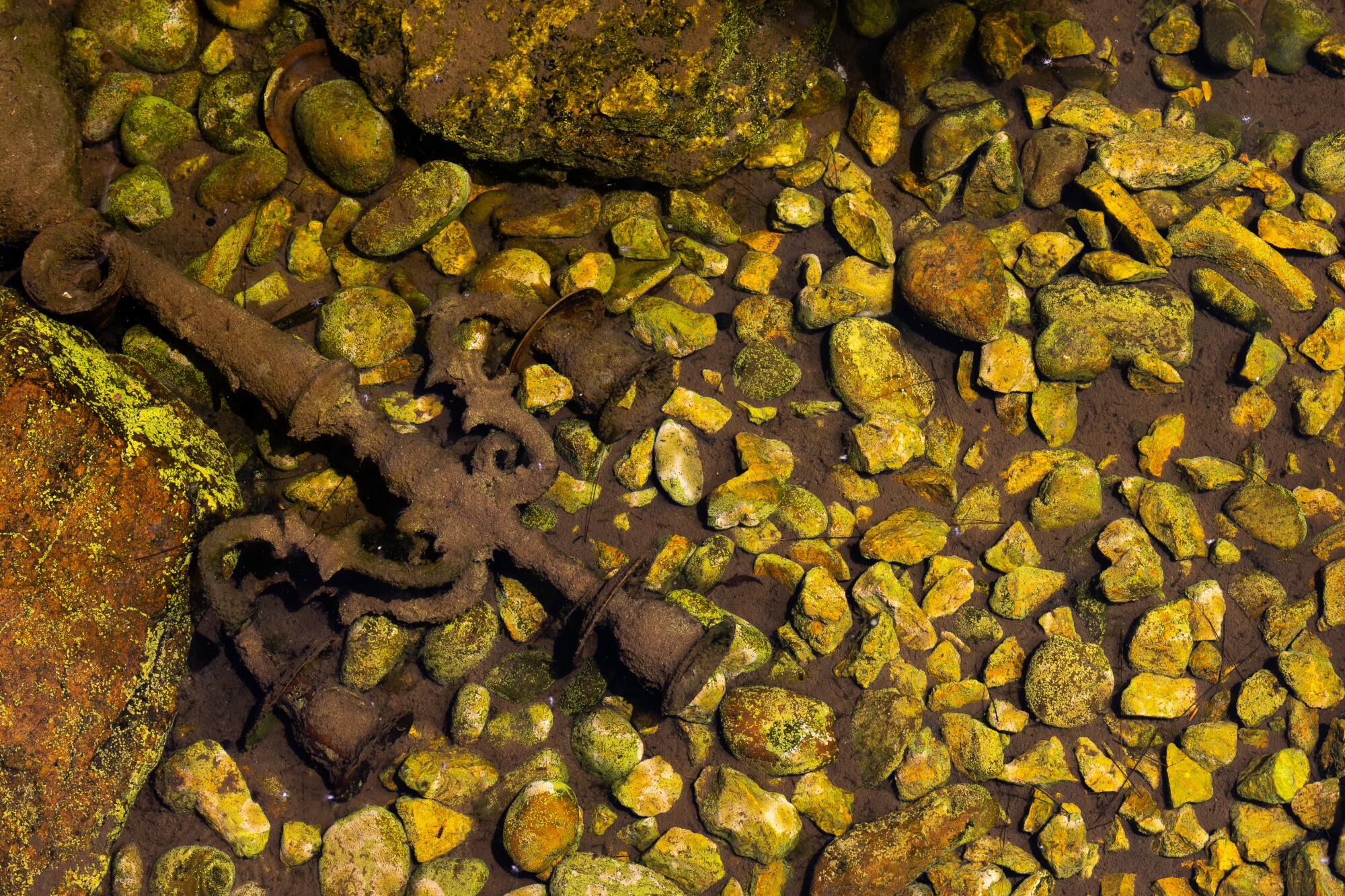
The salvaging got to be kind of joke. Odell’s firm was doing earthquake retrofits, and during site demolitions he’d discover some new artifacts, like industrial-sized valves that might have been used in oil fields or a box of long rusty files. “So I’d be at work,” Elwell said, “and get this text with photos of something like an old radiator followed by this question: ‘TREASURE?’”
Neighbors got into the act as well, inviting the couple over to look at things their elders had squirreled away decades earlier. “They’d say, ‘Dad hasn’t opened that door in 20 years; let’s see what’s in there.’”
The landscaping was part inspiration and part experiment, guided by fun, Elwell said, and plenty of mistakes.
Habitat gardens need more than native California plants. They need water for pollinators, birds and other animals. Here are tips for adding this water source.
One of the first was going whole hog into native plants without understanding anything about them. For instance, Odell loved the manzanitas that grow prolifically around his family’s 40-acre ranch in Shasta County.
So they got a tractor and dug one up to replant in L.A. “It looked great for about six weeks, and then it died,” Elwell said. “That’s how naive we were. So it became a research project — how do you get these things to grow?”
Their research led them to the website of Las Pilitas Nursery, a Santa Margarita grower specializing in California native plants. Bert Wilson, its founder, died in 2014, but his extensive descriptions about native plants “are super helpful to beginners,” Elwell said. “He approached it with a level of fun, writing things like, ‘I know this plant is really tough because we’ve run over it with a tractor several times and it always comes back.’”
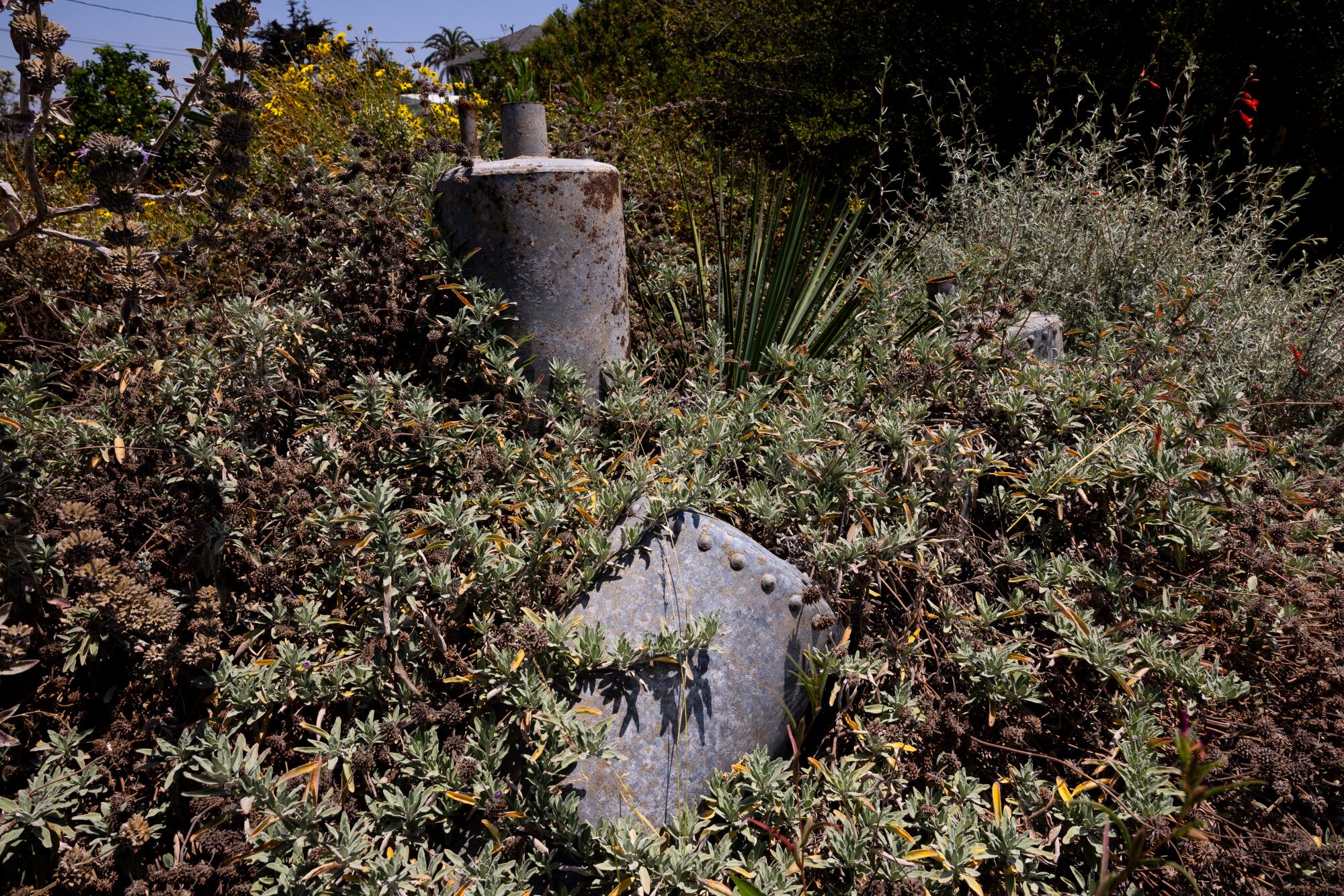
From there, they began frequenting the Theodore Payne Foundation in Sun Valley, one of Southern California’s premier native plant nurseries, “and as a new gardener, I just wanted to buy everything,” Elwell said. “I was treating the plants more like furniture than ecology. I’d say, ‘Oh, that looks cool.’ I was not thinking, ‘Does it really make sense to plant something that normally grows on an alpine slope at sea level in clay soil?’”
As their knowledge grew, their focus shifted to creating habitat for regional pollinators, birds and other animals. And habitats need water, a realization that had unexpected benefits.
When Odell broke his elbow in a mountain biking accident, he quickly mastered the simple rehabilitation exercises his doctor provided. So when Elwell said he wanted a pond in the front yard, Odell was immediately on board.
California native plants have many pros, but their potent scents are the biggest draw of all. Gardening experts share the most fragrant native plants.
“He’s just the kind of person where you point out what you want to do, and he says, ‘OK, let’s go,’” Elwell said. “So he just went charging in with a pickaxe to dig out the hole and a 30-pound digging bar to move the boulders” for a roughly 8-by-12-foot pond, complete with a small waterfall fed by recirculating water (flowing through an oversized recycled spigot) and a large boulder that he drilled out in the middle to provide a gentle bathing area for tiny drinkers. Oh, and a now-large toyon and mountain mahogany on either side to provide partial shade.
When Odell returned for a checkup a few weeks later, his doctor was amazed at how well his arm had healed. “He said, ‘How did you do that?’” Odell said, “And I said, ‘By doing everything you told me not to do.’”
They did bring in a contractor to build the spacious patios off the kitchen and living room, a long narrow koi pond with a Medusa head fountain and a wide swimming pool that follows the slope of the hill.
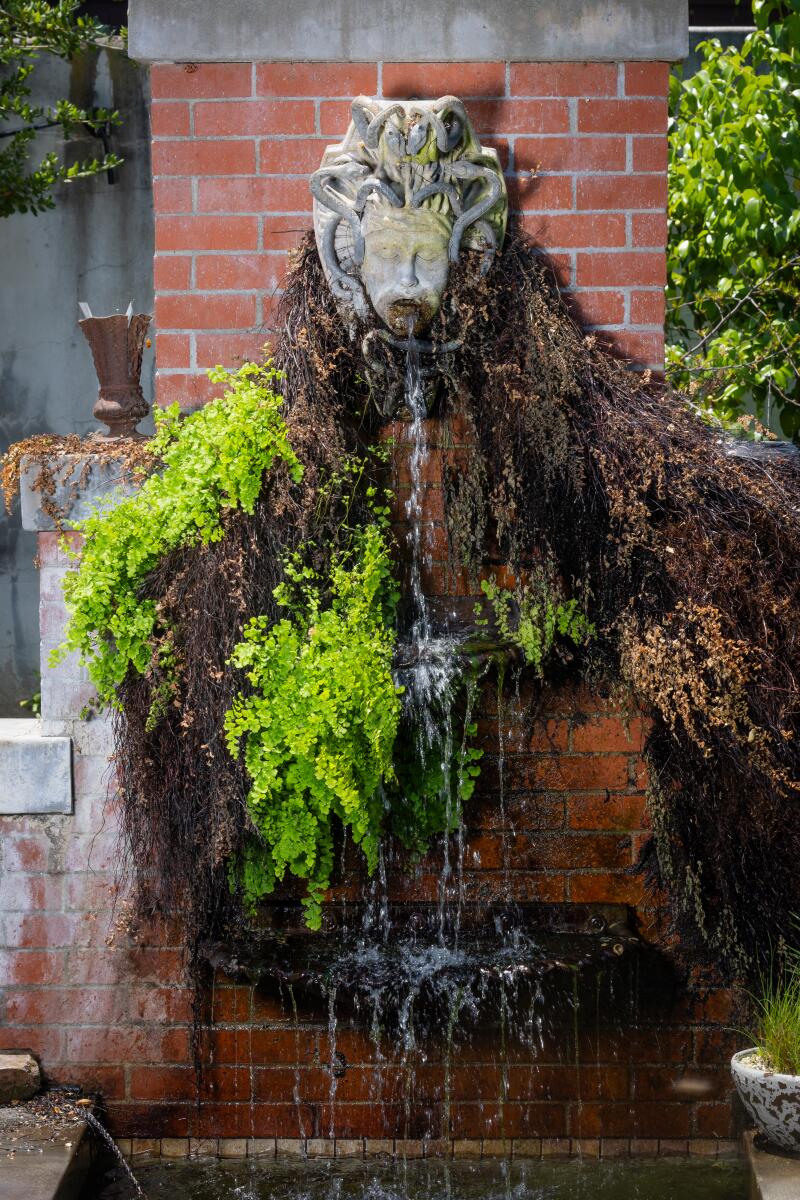
A fountain bearing a relief of Medusa’s head pours into the koi pond in the backyard.

Naked buckwheat.
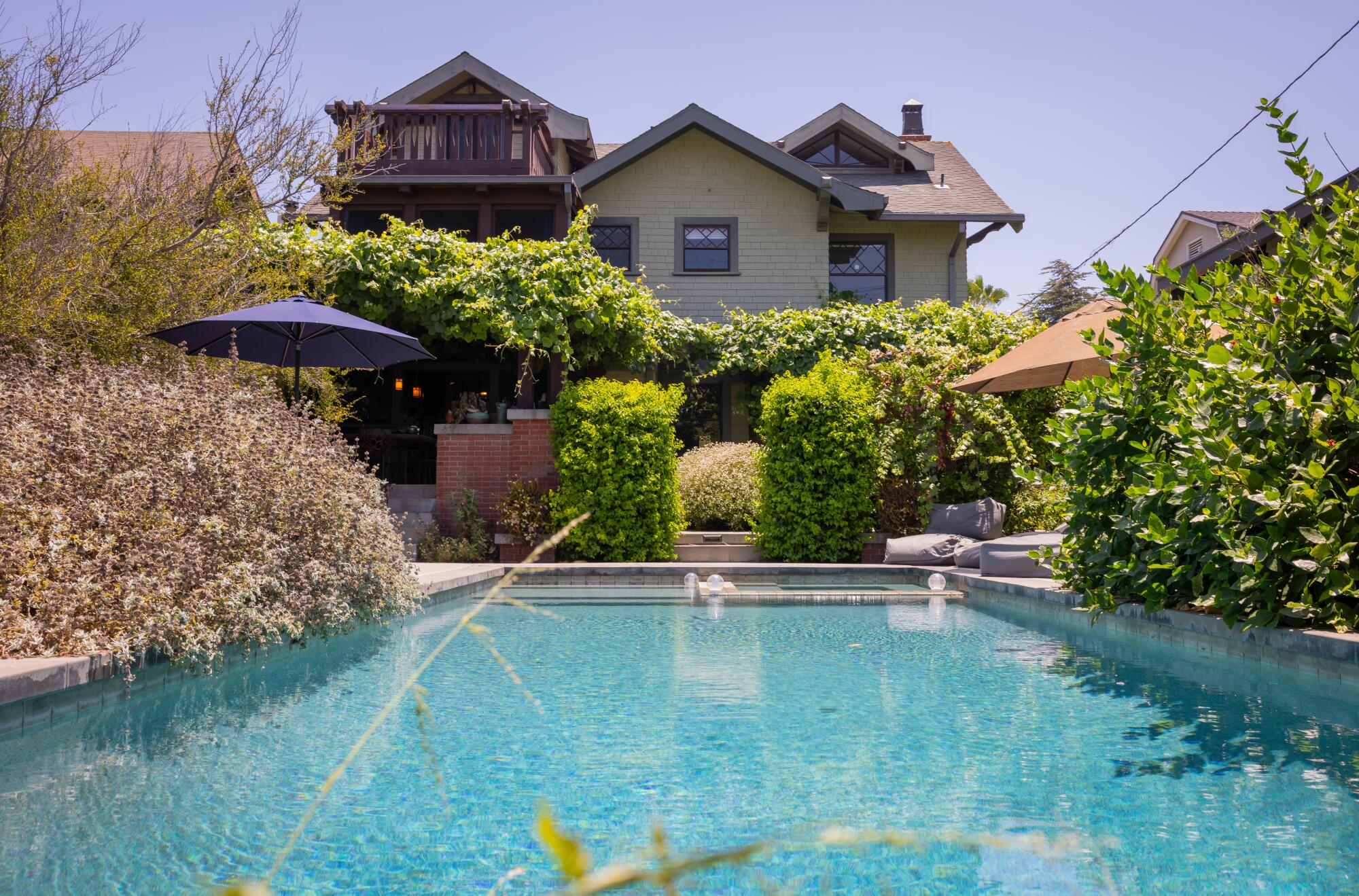
But that’s where their “modern” landscaping stops. Instead of lawn or little potted palms around the pool, there are oversize stands of desperado sage, a fragrant hybrid between white sage and purple sage, growing so untamed they’re nearly spilling into the pool.
Odell rented an excavator to slice the bottom of the slope into a cliff, shored up by the dirt excavated for the pool, along with recycled broken concrete and other rubble. He used old railroad tracks to create steps down to the bottom of the slope. He carved out a narrow ditch between the cliff and steps, and that became a recirculating stream that flows into a little marsh full of frogs, butterflies and dragonflies.
Like their home, the yard is divided into “rooms,” or separate experiences, so sitting by the pool, you can’t see the koi pond with its restless fish or the little stream burbling just 10 feet away, or the ornate handmade pergola that offers shade at the bottom of the hill.
Walking this yard is an adventure that reveals itself slowly. Years ago a Mama Bear manzanita (Arctostaphylos ‘Mama Bear’) finally took hold in their side yard, almost entirely covering the old driveway; further up, a hedge of citrus trees produce lemons the size of mangoes.
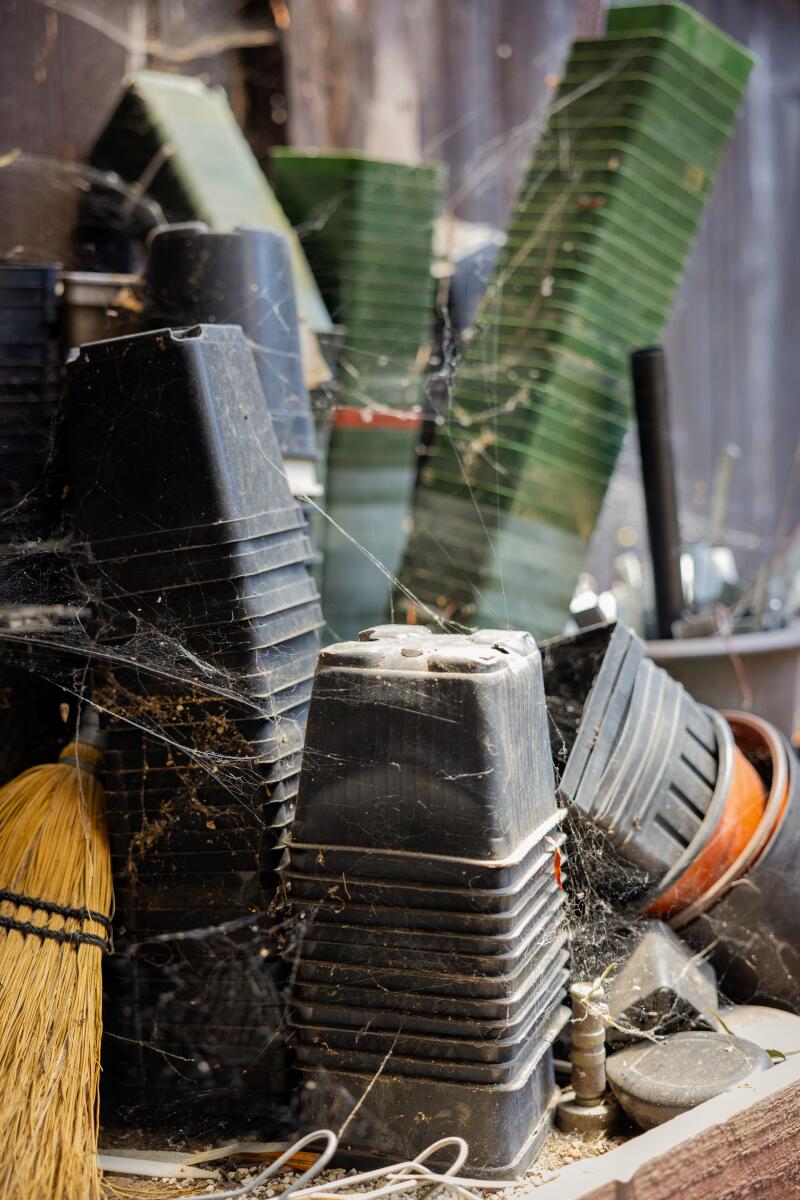
Plastic planters collect cobwebs on a shelf in the yard.

A dragonfly lands on a plant near one of the yard’s water features.
There are a few other fruit trees on the property, but mostly it’s a riot of native plants with enough variety that even in the summer, when many California native plants go dormant, the garden is full of fragrance and color — bright purple wands of woolly blue curls that smell as sweet as bubble gum; sticky yellow and red monkeyflowers, tall mallows with large flowers in orange and lavender, pinkish white bouquets on the narrow milkweed and sunflowers and fuchsias nearly ready to bloom.
Replacing lawns with drought-tolerant plants is a good start in dry Southern California. Setting up a recycled water system is even better.
Needless to say, friends and family don’t question their decision now. They deliberately designed the outdoors for entertaining, with a huge welcoming table off the kitchen and bobbing solar lanterns in the clear inviting pool. And over the years they bought the houses on either side of them, and now rent them out to a nephew and friends.
The gates between the properties are always open, and when it’s time for loved ones to gather, Elwell said, it’s only a matter of when — the “where” is never a question.
More to Read
Sign up for The Wild
We’ll help you find the best places to hike, bike and run, as well as the perfect silent spots for meditation and yoga.
You may occasionally receive promotional content from the Los Angeles Times.
